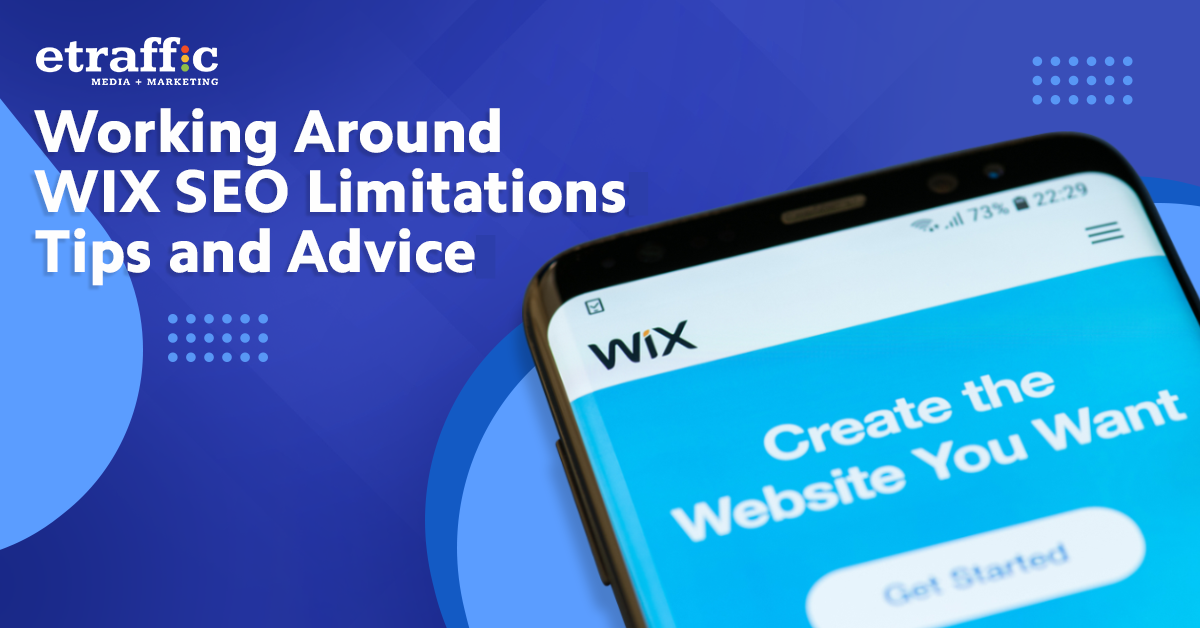![]() Posted by Cameron Francis
on
05 Apr , 2023
in
SEO Tips
Posted by Cameron Francis
on
05 Apr , 2023
in
SEO Tips

WIX is one of the most popular website builders today as it allows users to create professional-looking websites without the need for any coding experience. It offers a range of templates and tools to make the process of building a website easy and accessible to anyone. With over 200 million users worldwide, it’s no surprise that WIX has become a popular choice for businesses and individuals looking to establish an online presence.
However, WIX SEO problems are a common sight that impacts the ability of a website to rank, despite how good it may look. SEO is crucial for any online business because it determines how easily potential customers can find your website on search engines like Google. SEO involves a range of techniques and strategies to improve your website’s ranking on search engine results pages (SERPs). The higher your website ranks, the more visible it will be to potential customers, and the more traffic you’ll receive.
While WIX offers some SEO features, there are some limitations that can impact your website’s ranking. For example, WIX automatically generates URLs for each page on your website, which can’t be customised, and may not include relevant keywords.
WIX also has limited options for optimising images on your website, which can negatively impact your website’s load time and overall performance. Additionally, WIX has limited options for implementing structured data, which can reduce your website’s visibility in SERPs.
Despite these limitations, there are ways to work around them and improve your website’s SEO performance. In the following sections, we’ll explore some practical tips and best practices for working around WIX’s SEO limitations and improving your website’s ranking on search engines.
WIX is a website builder that is designed to make website creation accessible to anyone, regardless of their coding knowledge or experience. While this is a great benefit for many, it does come with some limitations, particularly when it comes to SEO.
One of the primary limitations of WIX’s SEO capabilities is its limited control over URLs. WIX automatically generates URLs for each page on your website, which can negatively impact your SEO. URLs are a crucial aspect of SEO because they give search engines an idea of what the page is about. However, because WIX automatically generates URLs, they may not be optimised for search engines. Additionally, they may not include relevant keywords that can help search engines understand the content of your website.
Another limitation of WIX’s SEO capabilities is the limited ability to optimise images on your website. While images are a crucial component of any website, they can also significantly impact your website’s load time and overall performance. Unfortunately, WIX’s platform has limited options for image optimisation, which can negatively affect your website’s SEO. Images that are too large or not optimised for the web can slow down your website, which can negatively impact your SEO performance.
WIX also has limited options for implementing structured data, which can reduce your website’s visibility in SERPs. Structured data is a way of marking up your website’s content so that search engines can understand it more easily. Structured data helps search engines understand the content on your website, and it can help your website rank higher in search results. However, because WIX has limited options for implementing structured data, your website may not rank as well in search results as it could.
These limitations exist because WIX is a closed platform, which means that users do not have full control over their website’s code. As a result, there are certain aspects of the website’s structure and design that cannot be optimised for SEO. Additionally, WIX’s website structure is not designed with SEO in mind, which can limit a website’s ability to rank well on search engines.
These limitations can negatively impact your website’s ranking on search engines, making it harder for potential customers to find your website. However, there are ways to work around these limitations and improve your website’s SEO performance.
One way to work around WIX’s SEO limitations is to customise your meta tags. While WIX automatically generates meta tags for your website, you can customise them to include relevant keywords and descriptions that will help improve your website’s ranking. Another way to improve your website’s SEO is to compress your images and add alt tags to your images. Alt tags help search engines understand what your images are about and can improve your website’s ranking in search results.
Additionally, you can use header tags to structure your content and include relevant keywords. Header tags (H1, H2, H3, etc.) are important for organising your content and signalling to search engines what your website is about. Adding structured data to your website can also improve your website’s visibility in search engine results pages. While WIX has limited options for implementing structured data, you can still add basic structured data to your website using Google’s Structured Data Markup Helper.
It’s also important to optimise your website’s content, structure, and design for better SEO performance. This includes conducting keyword research and including relevant keywords in your content, optimising your website’s structure to make it easy for search engines to crawl and index your pages, and making sure your website is mobile-friendly and has a fast load time.
While WIX has some limitations when it comes to SEO, there are ways to work around them and improve your website’s visibility in search engine results pages. By customising your meta tags, optimising your images, using header tags, adding structured data, and following SEO best practices such as creating high-quality, relevant content, building quality backlinks, and improving website speed and usability, you can enhance your website’s SEO performance on WIX.

WIX’s limitations can be frustrating when it comes to SEO, but there are ways to work around them and improve your website’s visibility in search engine results pages. Here are some practical tips for improving your WIX website’s SEO despite the limitations:
1). Customise your meta tags: While WIX automatically generates meta tags for your website, you can customise them to include relevant keywords and descriptions that will help improve your website’s ranking. Make sure to include relevant keywords in your meta tags, and keep them short and descriptive.
2). Optimise your images: While WIX has limited options for optimising images, you can still ensure that your images are optimised for the web. Compress your images to reduce their size, which will improve your website’s load time. You can also add alt tags to your images, which will help search engines understand what your images are about.
3). Use header tags: Header tags (H1, H2, H3, etc.) are important for organising your content and signalling to search engines what your website is about. Use header tags to structure your content and include relevant keywords.
4). Add structured data: While WIX has limited options for implementing structured data, you can still add basic structured data to your website using Google’s Structured Data Markup Helper. Adding structured data to your website can help search engines understand your content better, which can improve your website’s ranking.
5). Build high-quality backlinks: Backlinks are a key factor in determining a website’s authority and ranking in search engine results pages. Reach out to other websites in your niche and ask if they would be willing to link back to your website. Make sure to focus on building high-quality backlinks from reputable websites in your industry.
In addition to these tips, it’s important to optimise your website’s content, structure, and design for better SEO performance. Here are some specific examples of techniques that can be used to overcome WIX’s limitations:
By optimising your website’s content, structure, and design, you can improve your website’s SEO performance despite the limitations of WIX’s platform. It’s important to remember that SEO is an ongoing process, so make sure to regularly monitor your website’s performance and make data-driven improvements to your website. With these tips and best practices in mind, you can improve your WIX website’s SEO and increase your website’s visibility in search engine results pages.

Following are some of the best practices you should follow to ensure that your WIX site is properly optimised for maximum impact:
Keyword research is the foundation of any successful SEO strategy. Start by identifying the keywords and phrases that your target audience is searching for in relation to your product or service. Use tools like Google Keyword Planner, SEMrush, or Ahrefs to research relevant keywords and phrases that you can include in your website’s meta tags, titles, and content. Use long-tail keywords that are more specific and have lower competition to increase your chances of ranking higher in search engine results pages (SERPs).
On-page optimisation involves making sure that your website’s content is optimised for search engines. Include your target keywords in your titles, headers, meta descriptions, and content. Use header tags (H1, H2, H3) to organise your content and make it more scannable. Use internal linking to create a logical flow between pages and make it easier for search engines to crawl and index your website. Additionally, make sure your website’s content is well-written, engaging, and provides value to your readers.
Backlinks are a key factor in determining a website’s authority and ranking in search engine results pages. Focus on building high-quality backlinks from reputable websites in your industry. One way to do this is by creating high-quality content that other websites will want to link to. Reach out to other websites in your niche and ask if they would be willing to link back to your website. Avoid buying backlinks or using spammy tactics, as this can harm your website’s ranking and reputation.
Creating high-quality, informative content is essential for improving your website’s ranking on search engines. Make sure your content is relevant to your target audience and includes relevant keywords. Use different types of content such as blog posts, videos, infographics, and podcasts to keep your website fresh and engaging. Additionally, make sure to update your website with fresh content regularly to keep it relevant and up-to-date.
More and more people are using mobile devices to access the internet, so it’s essential to make sure your website is optimised for mobile. Use responsive design to ensure your website looks and functions well on all devices. A mobile-friendly website not only improves user experience but also improves your website’s ranking on search engines.
Use tools like Google Analytics to track your website’s performance and identify areas for improvement. Use data to make informed decisions about how to optimise your website for better SEO performance. Keep an eye on your website’s traffic, bounce rate, and conversion rate to identify areas that need improvement. Regularly monitoring your website’s performance will help you to identify what’s working and what’s not, allowing you to make data-driven improvements that will benefit your website’s SEO performance in the long term.
Following these best practices can help you to improve your WIX website’s SEO performance despite the platform’s limitations. By conducting keyword research, optimising on-page elements, building high-quality backlinks, creating high-quality content, making your website mobile-friendly, and tracking your website’s performance, you can increase your website’s visibility in search engine results pages and attract more organic traffic to your website. Remember that SEO is an ongoing process, so it’s essential to continuously monitor and make data-driven improvements to your website to stay ahead of the competition.
Some key takeaways to consider from this article include:
For those working with WIX and looking to improve their SEO performance, the final word of advice is to be patient and persistent. SEO is a long-term strategy that requires ongoing effort and optimisation. Keep track of your website’s performance, make data-driven improvements, and stay up-to-date with the latest SEO best practices. With these tips and best practices in mind, you can improve your WIX website’s SEO and increase your website’s visibility in search engine results pages.
If you’re looking to improve your WIX website’s SEO performance but don’t have the time or expertise to do it yourself, consider reaching out to ETRAFFIC for assistance. ETRAFFIC is a leading digital marketing agency with years of experience helping businesses of all sizes to optimise their websites for search engines.
Our team of SEO experts can help you to identify areas for improvement, implement best practices, and track your website’s performance to ensure that you’re getting the best possible results. With our help, you can take your WIX website to the next level and attract more organic traffic to your website. Contact us today to learn more about our services and how we can help you to achieve your SEO goals.
Please call us at ETRAFFIC today at 1300 887 151 or book a free strategy session below.